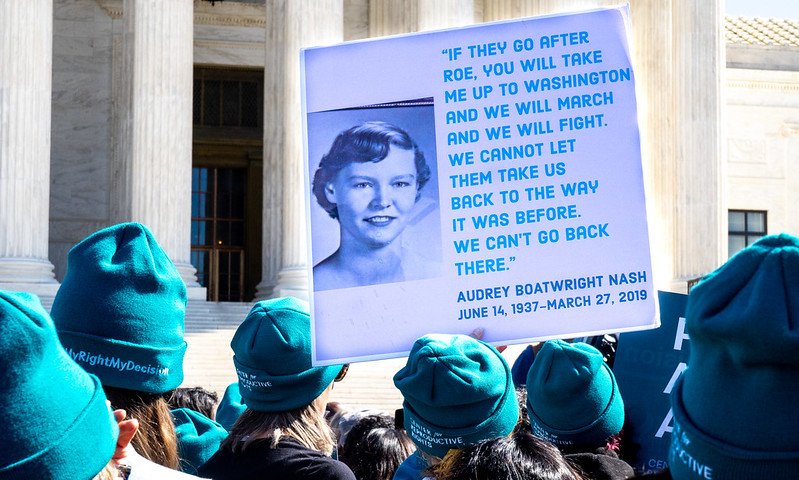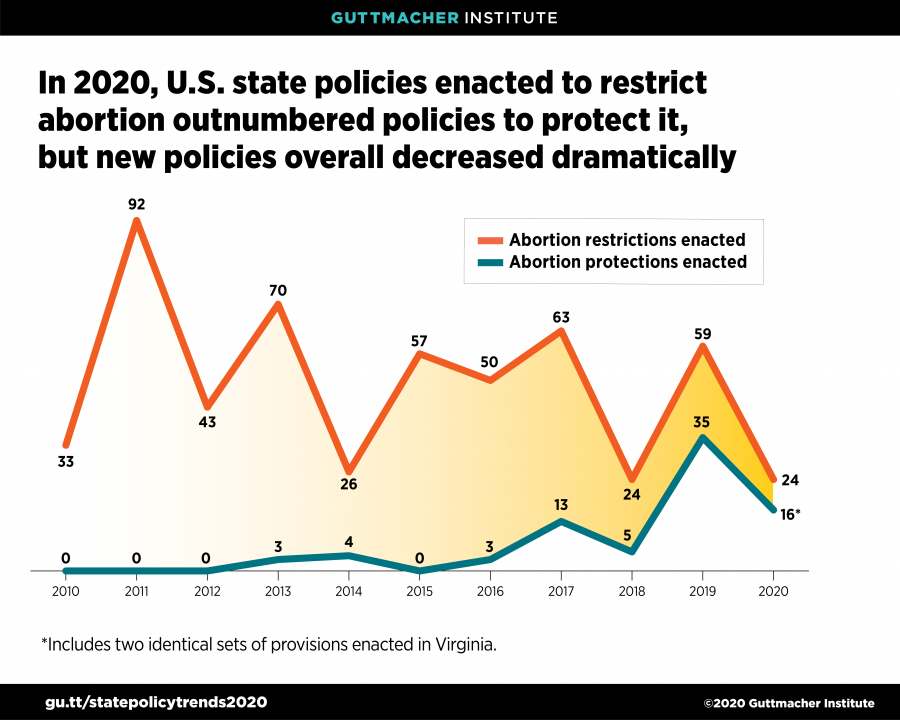
Last week, the Guttmacher Institute published its 2020 end-of-year state policy trends analysis. This excerpt has been republished with permission. Read the full report here.
The year 2020 was nothing if not extraordinary. There was a global pandemic and recession, calls to address racial injustice and police brutality after the racist killings of Black Americans—including George Floyd, Breonna Taylor, Ahmaud Arbery and Rayshard Brooks—and tumultuous elections.
In the first half of the year, responding to the coronavirus pandemic was the most important issue for state policymakers. The pandemic spurred governors and state legislatures across the country to focus on supporting their residents’ health care access and providing expanded safety-net programs. At the same time, many governors pursued one of two diametrically opposed courses of action: either protecting access to reproductive health care or attempting to ban abortion.
In June, the U.S. Supreme Court struck down an abortion restriction: In June Medical Services LLC v. Russo, a 5-4 majority of the Court struck down a Louisiana admitting privileges law that would have reduced the number of abortion clinics in the state to one, and limited the capacity of abortion providers by up to 70 percent.
But the opinion left the door open for states to adopt other similar restrictions. Indeed, lower courts are already incorporating this ruling into their decisions. For example, appellate courts have upheld abortion restrictions in Arkansas and Kentucky related to clinic regulations, and upheld a law that would allow the Louisiana and Texas Medicaid programs to exclude abortion providers.

In the midst of the pressing issues of the past year, state legislatures also addressed reproductive health, but not as much as in recent years.
This year, 24 abortion restrictions were enacted, as were 16 provisions that protect and expand access to abortion services (including two identical sets of provisions in Virginia), and another 74 provisions that expand access to reproductive health services and education. However, there were about half as many total provisions enacted as there were in 2019.
(Counts of this year’s provisions follow this analysis.)
Coronavirus Crisis
As state governors responded to the COVID-19 pandemic, they affected reproductive care in countless ways. Governors issued orders to protect access to health care, preserve supplies of protective equipment, and reduce exposure to and transmission of the coronavirus. In some states, these orders protected reproductive health care; in others, governors used the pandemic as an excuse to restrict this care. The orders expired over the summer, as the pandemic eased in many states.
Executive orders in 23 states protected access to reproductive health care during the initial stages of the pandemic. Some of these state orders ensured access to obstetric and gynecologic care, or reproductive care generally, while others specifically included access to abortion, family planning and pregnancy-related care. The governors in these states recognized that this care is essential and timely, and has a profound impact on a patient’s life and well-being.
Governors in 11 states, mostly in the South, used the pandemic to restrict access to abortion care by issuing orders that prohibited abortion in the name of preserving protective equipment. However, because abortion care requires little or no protective equipment and is essential to individuals’ health, courts prohibited the orders from taking effect in most of these states. Some orders were temporarily allowed to take partial or full effect; as a result, abortion care was disrupted in Arkansas, Ohio, Tennessee and Texas during the spring.
Abortion
In 2020, abortion restrictions were not as much a focus of state legislatures as they had been in recent years, but more legislation was passed last year than in the period from the mid-1980s through the early 2000s.
Tennessee enacted the most comprehensive legislation: The state banned abortion as early as six weeks of pregnancy, banned abortion for sex or race selection or Down syndrome, required an ultrasound before the abortion and counseling that a medication abortion can be reversed, and imposed more barriers on minors seeking abortion and additional limits on postviability abortion. (The provisions related to the six-week abortion ban and the medication “abortion reversal” counseling requirement are not in effect as a result of legal challenges.)
Nine other states also enacted new restrictions:
- Mississippi banned abortion for sex or race selection or genetic anomaly.
- North Dakota banned the standard method of abortion used after 15 weeks of pregnancy.
- Idaho and Utah banned abortion if Roe v. Wade is overturned.
- Oklahoma and Utah amended their clinic regulations.
- Indiana and Utah added to their counseling requirements.
- Iowa required patients to make two visits (one for counseling and the second for the abortion) but the restriction is not in effect due to court action.
- Florida mandated notarized parental consent.
- Mississippi amended its abortion reporting requirements.
- West Virginia required physicians to preserve the life of a fetus delivered alive after an abortion.

Pregnancy Care and Maternal Mortality
Fully 40 percent of the enacted provisions on reproductive health and rights in 2020 seek to improve the quality of and access to pregnancy-related care, including enhancing state committees that examine maternal mortality and providing reproductive health care for incarcerated individuals.

Looking Ahead to the State of Reproductive Health in 2021
In 2021, state legislatures will face an unprecedented situation, as they attempt to mitigate the effects of the pandemic; contend with reduced tax revenue and budgets; and begin to address systems based on racial discrimination, including housing, employment, policing, education and health care.
It remains to be seen whether reproductive health will receive as much attention as it did in 2020 or in previous years.
Topline Numbers (Counts of state legislation from January 1, 2020 – December 1, 2020)
Reproductive Health and Rights Overall
- 1,328 provisions introduced in state legislatures on all reproductive health and rights topics
- 121 provisions enacted
- 509 provisions introduced that would protect reproductive rights or expand access to reproductive health
- 90 provisions enacted
- 289 provisions introduced that would restrict access to reproductive health or curtail rights
- 27 provisions enacted

Abortion
- 131 provisions introduced that would protect or expand access to abortion care
- 16 provisions enacted
- 236 provisions introduced that would restrict access to abortion care
- 24 provisions enacted
- 480 provisions restricting access to abortion care have been enacted since the beginning of 2011
Contraception
- 152 provisions introduced that would protect or expand access to contraceptive services
- 19 provisions enacted
Maternal Health
- 158 provisions introduced that would expand access to or improve the quality of maternal health care
- 50 provisions enacted
Read the full analysis at Guttmacher.org.
You may also like:












